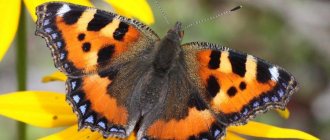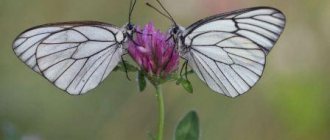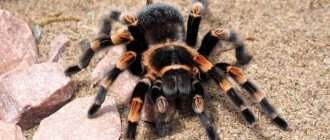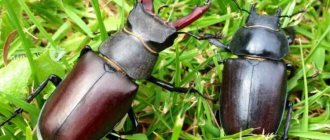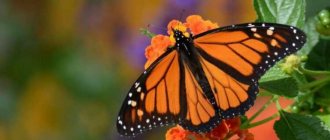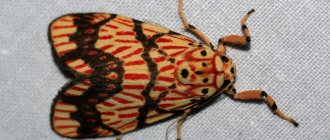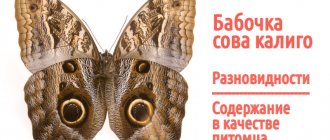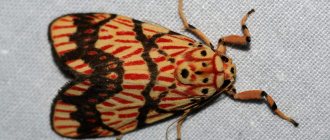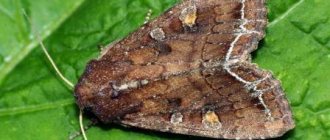Description
The agrimony is a very large butterfly with a wingspan of 47-65 mm. The main background of the wings is light brick red with black spots. There are white spots at the black corners of the upper wings. There is a white border along the edge of the wings. At the outer edge of the hind wings there is a row of rounded black dots. The bottom of the front wings is slightly pinkish, with black spots, the hind wings are brown-gray with white spots and 4-5 ocellated spots - yellow with a blue core, trimmed with a black border.
Interesting facts about butterflies
- The Saturnia butterfly's caterpillar is so poisonous that the toxins it produces can kill humans.
- The migratory monarch butterfly is capable of covering up to 1000 km in one flight without stopping to rest.
- Butterflies do not sleep at night because they do not need sleep.
- When flying over short distances, hawk moths can reach speeds of up to 60 km/h.
- The baby moth is the smallest butterfly with wings measuring 2 mm.
- Madagascar hawkmoths have the longest proboscis, which is 28 cm long.
- The size of the wings of the butterfly Tisania agrippina reaches 31 cm.
- The peacock butterfly's sense of smell is very developed: it can smell it at a distance of 10 km.
Nutrition and lifestyle
The burdock is one of the most famous migratory butterflies. In Europe it appears at the end of May or beginning of June, having covered up to 5000 km, returning from North Africa and Arabia, and in September it goes back. At the same time, the butterfly lays eggs in wintering areas, and this ends its annual life cycle. Caterpillars emerge from the eggs and then turn into pupae. In the spring, new butterflies emerge from them, which again gather in flocks and return, covering long distances to breed a new generation. And it, in turn, will fly south.
Adults feed mainly on the nectar of various flowering plants, but still give preference to asteraceae. They can often be seen in gardens, parks and meadows, sitting on thistle and aster flowers. The burdock caterpillar is polyphagous; it can eat leaves of soybean, milk thistle, thistle, sow thistle, mallow and many other plants. During years of mass reproduction, it can cause damage to soybean crops, and yet the species is included in the Red Book of certain regions and regions.
Benefit or harm
If you think about the impact of the burdock butterfly on the environment, then this impact can be considered minimal. Thistle caterpillars mainly attack weeds, and even then in small quantities.
The freezing of entire generations in some areas leads to a reduction in the number of thistles as a species. This state of affairs makes us think about protecting these beautiful butterflies.
For example, in the Smolensk region, the burdock butterfly was listed in the regional Red Book in 1997.
Today's video will show how the burdock butterfly behaves in nature. Filmed at Tower Hill Botanical Garden, Massachusetts, United States of America.
Life cycle
After a long period of additional feeding on flowering weeds, the fertilized female lays 1 greenish egg on the leaves of the food plants and soon dies. After 1-2 weeks, the caterpillars hatch. They build themselves shelter boxes from several folded leaves, where they feed. During its life (about a month), the caterpillar makes about 7-9 such boxes and goes through 5 developmental phases before it turns into a pupa.
The pupal stage lasts 2-3 weeks, after which a new generation of butterflies emerge. In the southern regions of Eastern Europe, up to 4 generations per year are possible, depending on climatic conditions.
Distribution area
Thistle butterflies have a very wide distribution. They cannot be found only in Antarctica and South America. Its northern limit of distribution reaches the tundra. But in the high latitudes of this area the butterfly does not reproduce. It winters in the southern parts of Europe.
One well-known fact should be mentioned - sometimes the burdock butterfly flies to the northern islands of Spitsbergen, Iceland and Kolguev.
Preferred habitats of the butterfly:
- forest edges;
- roadsides;
- marginal areas of fields;
- plots of vegetable gardens and summer cottages;
- mixed grass meadows;
- slopes of mountains and hills;
- coastal areas of reservoirs.
Notes
- Korshunov Yu. P.
Keys to the flora and fauna of Russia // Mace Lepidoptera of Northern Asia. Issue 4. - M.: Partnership of Scientific Publications KMK, 2002. - P. 59. - ISBN 5-87317-115-7. - ↑ Lvovsky A.L., Morgun D.V.
Keys to the flora and fauna of Russia. Issue 8 // Lepidoptera of Eastern Europe. - M.: Partnership of Scientific Publications KMK, 2007. - 443 p. — 2000 copies. — ISBN 978-5-87317-362-4. - Lampert K.
Atlas of butterflies and caterpillars. - Minsk: Harvest, 2003. - 735 p. — 5000 copies. — ISBN 985-13-1664-4. - ↑ I. G. Plyushch, D. V. Morgun, K. E. Dovgailo, N. I. Rubin, I. A. Solodovnikov. "Day butterflies of Eastern Europe". CD identifier, database and Lysandra software package. Minsk, 2005
- Yu. Nekrutenko, V. Chikolovets - Daytime butterflies of Ukraine. Kyiv, 2005
- ↑ Bolotov I.N. Long-term changes in the fauna of lepidoptera (Lepidoptera, Diurna) of the northern taiga of the western Russian Plain. - Ecology, 2004. No. 2. P. 141-147.
- Bolotov I.N. Fauna and ecology of lepidoptera (Lepidoptera, Rhopalocera) of the Kanin Peninsula and Kolguev Island. - Zool. magazine 2011. T. 90. No. 11. P. 1365–1373.
- V.V. Hunchback Geographical structure of the fauna of diurnal butterflies (Lepidoptera, Diurna) of South-Eastern Fennoscandia. // Proceedings of the Karelian Scientific Center of the Russian Academy of Sciences No. 2. 2013. pp. 65–77
- Tom Tolman, Richard Lewington: Die Tagfalter Europas und Nordwestafrikas, S. 149, Franckh-Kosmos Verlags-GmbH & Co, Stuttgart 1998, ISBN 3-440-07573-7
- ↑ Bolotov I.N. Lepidoptera (Lepidoptera, Rhopalocera) of Arkhangelsk and its environs. - Zool. magazine 2002. T. 81. No. 4. P. 457-462.
- ↑ Bolotov I.N., Podbolotskaya M.V., Kolosova Yu.S., Zubriy N.A. The modern flow of migrants and its role in the formation of faunas of lepidoptera (Lepidoptera, Rhopalocera) on sea islands with young allochthonous biota. - Izv. RAS. Ser. Biol. 2013. No. 1. p. 88–98.
- M. P. Cornelio. School atlas-identifier of butterflies. - M. Education, 1986. 255 p.
- Harlan Abbott Charles, A Quantitative Study of the Migration of the Painted Lady Butterfly, Vanessa Cardui L. Ecology, Vol. 32, No. 2 (Avril 1951), pp. 155-171.
- Tom Tolman, Richard Lewington: Die Tagfalter Europas und
Nordwestafrikas
, S. 149, Franckh-Kosmos Verlags-GmbH & Co, Stuttgart 1998, ISBN 3-440-07573-7 - Michael Chinery, Les insectes d'Europe en couleurs
, Bordas, 1981, p.189, ISBN 2-04-012575-2
Excerpt characterizing Burdock
In such a mood, the field marshal, naturally, seemed to be only a hindrance and a brake on the upcoming war. To avoid clashes with the old man, a way out was found by itself, which consisted in, as at Austerlitz and as at the beginning of the campaign under Barclay, to remove from under the commander-in-chief, without disturbing him, without announcing to him that the ground of power on which he stood , and transfer it to the sovereign himself. For this purpose, the headquarters was gradually reorganized, and all the significant strength of Kutuzov’s headquarters was destroyed and transferred to the sovereign. Tol, Konovnitsyn, Ermolov - received other appointments. Everyone said loudly that the field marshal had become very weak and was upset about his health. He had to be in poor health in order to transfer his place to the one who took his place. And indeed, his health was poor. Just as naturally, and simply, and gradually, Kutuzov came from Turkey to the treasury chamber of St. Petersburg to collect the militia and then into the army, precisely when he was needed, just as naturally, gradually and simply now, when Kutuzov’s role was played, to take his place a new, needed figure appeared. The war of 1812, in addition to its national significance dear to the Russian heart, should have had another – European one. The movement of peoples from West to East was to be followed by the movement of peoples from East to West, and for this new war a new figure was needed, with different properties and views than Kutuzov, driven by different motives. Alexander the First was as necessary for the movement of peoples from east to west and for the restoration of the borders of peoples as Kutuzov was necessary for the salvation and glory of Russia. Kutuzov did not understand what Europe, balance, Napoleon meant. He couldn't understand it. The representative of the Russian people, after the enemy was destroyed, Russia was liberated and placed at the highest level of its glory, the Russian person, as a Russian, had nothing more to do. The representative of the people's war had no choice but death. And he died. Pierre, as most often happens, felt the full weight of the physical deprivations and stresses experienced in captivity only when these stresses and deprivations ended. After his release from captivity, he came to Orel and on the third day of his arrival, while he was going to Kyiv, he fell ill and lay sick in Orel for three months; As the doctors said, he suffered from bilious fever. Despite the fact that the doctors treated him, bled him and gave him medicine to drink, he still recovered. Everything that happened to Pierre from the time of his liberation until his illness left almost no impression on him. He remembered only grey, gloomy, sometimes rainy, sometimes snowy weather, internal physical melancholy, pain in his legs, in his side; remembered the general impression of misfortune and suffering of people; he remembered the curiosity that disturbed him from the officers and generals who questioned him, his efforts to find a carriage and horses, and, most importantly, he remembered his inability to think and feel at that time. On the day of his release, he saw the corpse of Petya Rostov. On the same day, he learned that Prince Andrei had been alive for more than a month after the Battle of Borodino and had only recently died in Yaroslavl, in the Rostov house. And on the same day, Denisov, who reported this news to Pierre, between conversations mentioned Helen’s death, suggesting that Pierre had known this for a long time. All this seemed strange to Pierre at the time. He felt that he could not understand the meaning of all this news. He was only in a hurry then, as quickly as possible, to leave these places where people were killing each other, to some quiet refuge and there to come to his senses, rest and think about all the strange and new things that he had learned during this time. But as soon as he arrived in Orel, he fell ill. Waking up from his illness, Pierre saw around him his two people who had arrived from Moscow - Terenty and Vaska, and the eldest princess, who, living in Yelets, on Pierre's estate, and having learned about his release and illness, came to him to visit behind him. During his recovery, Pierre only gradually unaccustomed himself to the impressions of the last months that had become familiar to him and got used to the fact that no one would drive him anywhere tomorrow, that no one would take his warm bed away, and that he would probably have lunch, tea, and dinner. But in his dreams, for a long time he saw himself in the same conditions of captivity. Pierre also gradually understood the news that he learned after his release from captivity: the death of Prince Andrei, the death of his wife, the destruction of the French. A joyful feeling of freedom - that complete, inalienable, inherent freedom of man, the consciousness of which he first experienced at his first rest stop, when leaving Moscow, filled Pierre's soul during his recovery. He was surprised that this internal freedom, independent of external circumstances, now seemed to be abundantly, luxuriously furnished with external freedom. He was alone in a strange city, without acquaintances. Nobody demanded anything from him; they didn’t send him anywhere. He had everything he wanted; The thought of his wife that had always tormented him before was no longer there, since she no longer existed. - Oh, how good! How nice! - he said to himself when they brought him a cleanly set table with fragrant broth, or when he lay down on a soft, clean bed at night, or when he remembered that his wife and the French were no more. - Oh, how good, how nice! - And out of old habit, he asked himself: well, then what? What will i do? And immediately he answered himself: nothing. I will live. Oh, how nice! The very thing that tormented him before, what he was constantly looking for, the purpose of life, now did not exist for him. It was no coincidence that this sought-after goal of life did not exist for him at the present moment, but he felt that it did not and could not exist. And it was this lack of purpose that gave him that complete, joyful consciousness of freedom, which at that time constituted his happiness. He could not have a goal, because he now had faith - not faith in some rules, or words, or thoughts, but faith in a living, always felt God. Previously, he sought it for the purposes that he set for himself. This search for a goal was only a search for God; and suddenly he learned in his captivity, not in words, not by reasoning, but by direct feeling, what his nanny had told him long ago: that God is here, here, everywhere. In captivity, he learned that God in Karataev is greater, infinite and incomprehensible than in the Architect of the universe recognized by the Freemasons. He experienced the feeling of a man who had found what he was looking for under his feet, while he strained his eyesight, looking far away from himself. All his life he had been looking somewhere, over the heads of the people around him, but he should have not strained his eyes, but only looked in front of him.
Conditions of detention
From an aesthetic point of view, it is more interesting to keep daytime butterflies, but it is worth considering that these insects are also attracted to light. During the day, the pet will tend to the window or sit on the curtains, and with the onset of darkness it will be drawn to all the lamps that are on.
Of course, the butterfly needs to be released to fly around the apartment, but it must have its own home. For this you can use:
- Plastic container;
- large glass jar;
- insectarium.
An insectarium equipped with special equipment or at least a large plastic container will be required when breeding butterflies
And with normal maintenance, this is important if other animals live in the house, especially cats. Otherwise, with a butterfly flying freely around the apartment, there will at least be no curtains on the windows
And during the hunt, both pets can suffer.
At temperatures from +22 °C and humidity within 60-80%, butterflies are active throughout the day. If the air in the apartment is excessively dry, the insect is sprayed with a spray bottle 1-2 times a day from a distance of about 30 cm from the wings.
The more time the pet spends in free space, the better. Some owners only place the insect at night in an ordinary box, where they put a sponge moistened with water, and during the day they let it fly around the apartment.
And now the main question that worries potential owners of winged beauties: what to feed a butterfly at home?
How long do butterflies live at home and in the wild?
Then, spreading out, they begin to feed on the pulp of the underside of the leaves. The secretions of the caterpillar's body glands cause skin irritation in humans. There have been cases of poisoning and death of birds eating caterpillars.
Young caterpillars prefer to feed on the underside of leaves, while older ones prefer to feed on the top.
Third instar caterpillars crawl away and live separately from others. They eat holes in the leaves of young cabbage heads, leaving only thick veins. They can migrate long distances in search of food.
Forage plants: horseradish, cabbage, field cabbage, garden cabbage, turnip, turnip, shepherd's purse, radish.
Doll. The pupa is yellowish-green, with black spots and dots and a tubercle on the back. For pupation, the caterpillar is attached with a belt of silk thread to substrates - on tree trunks, on fences, stones, stumps, etc.
d. The diapausing pupa overwinters.
Butterflies are one of the most beautiful and amazing insects on earth. There are more than 250,000 varieties.
The beauty of these fluttering creatures has inspired more than one artist, sculptor, poet... Many are fascinated by collecting these amazing creatures.
We invite you to look at photographs of the most unusual and magnificent butterflies on our planet.
